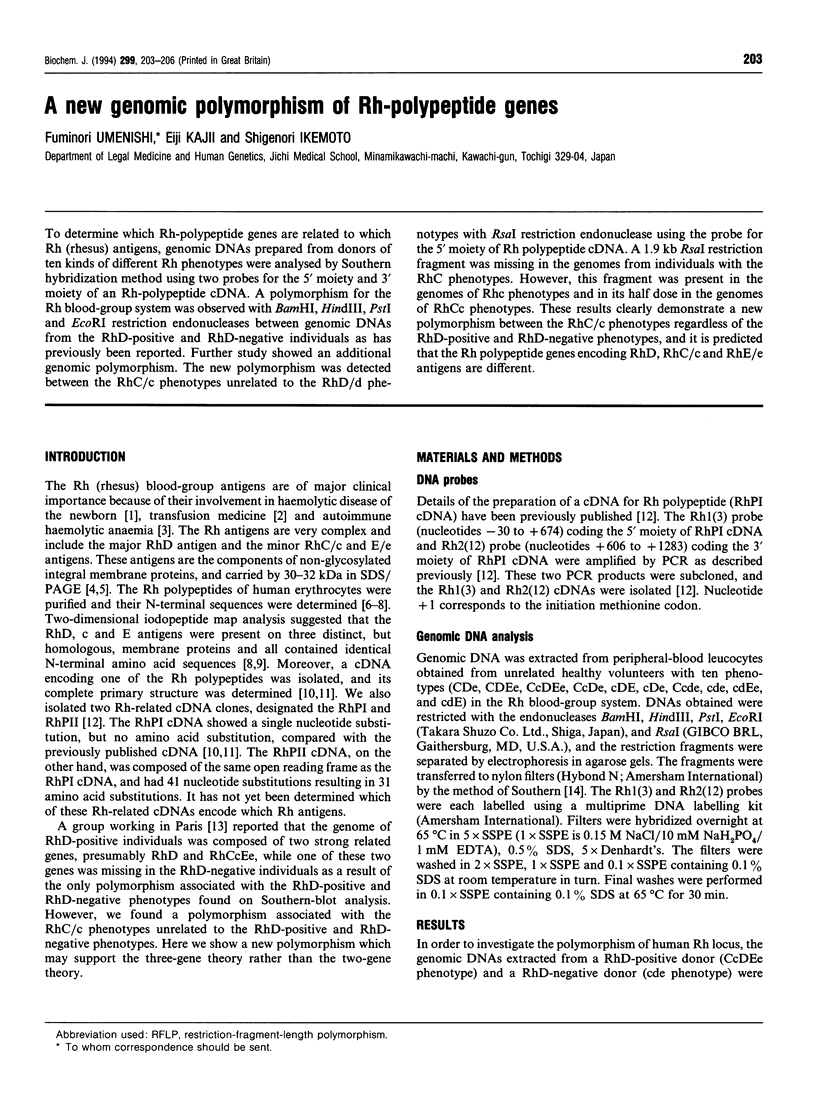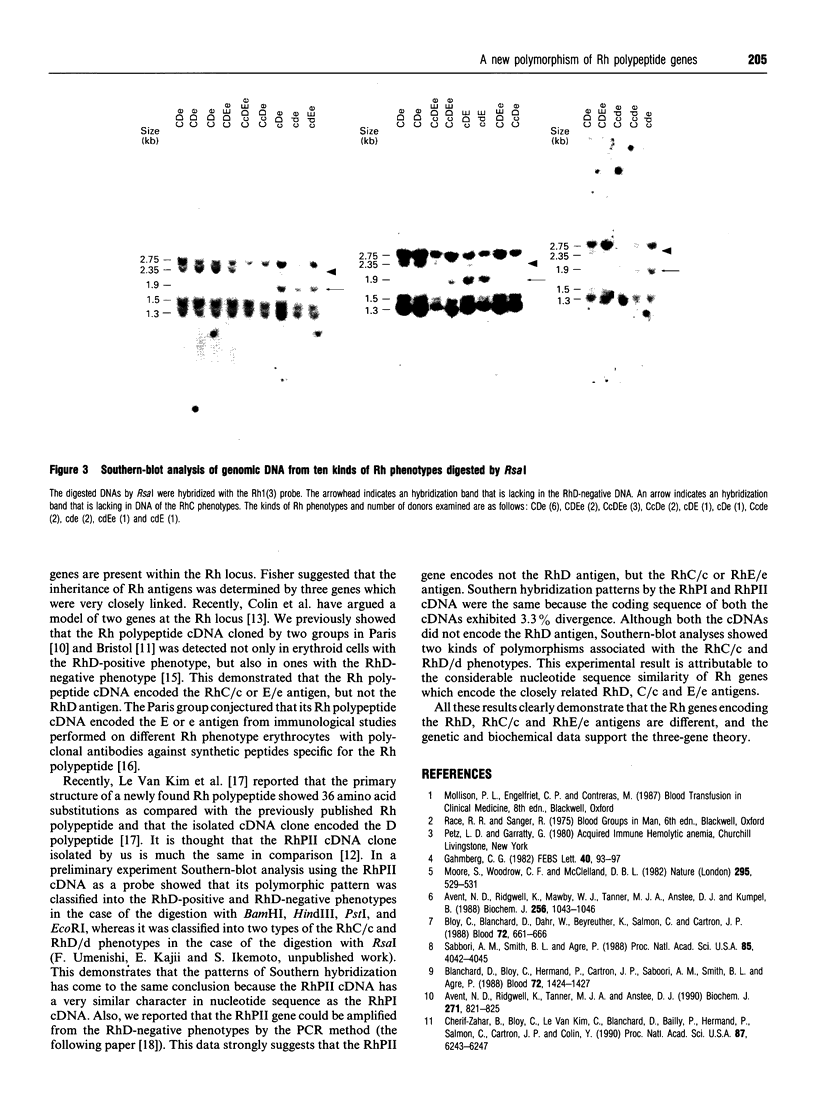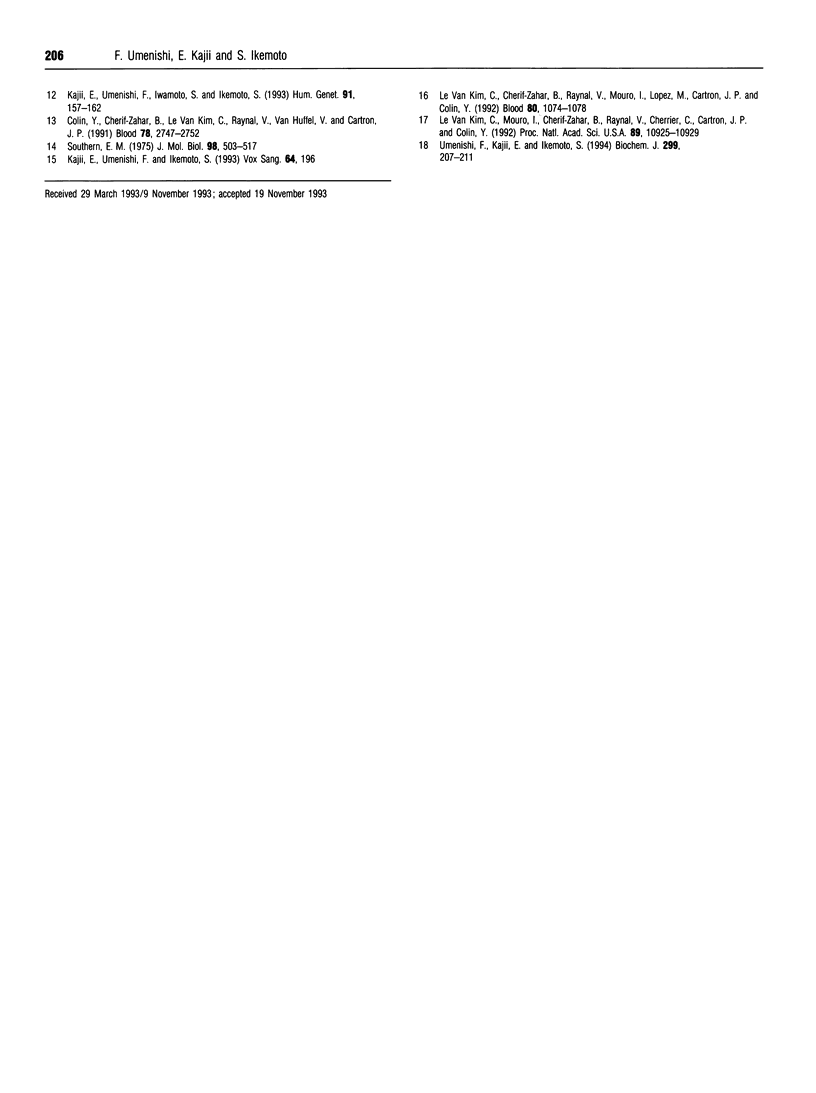Abstract
To determine which Rh-polypeptide genes are related to which Rh (rhesus) antigens, genomic DNAs prepared from donors of ten kinds of different Rh phenotypes were analysed by Southern hybridization method using two probes for the 5' moiety and 3' moiety of an Rh-polypeptide cDNA. A polymorphism for the Rh blood-group system was observed with BamHI, HindIII, PstI and EcoRI restriction endonucleases between genomic DNAs from the RhD-positive and RhD-negative individuals as has previously been reported. Further study showed an additional genomic polymorphism. The new polymorphism was detected between the RhC/c phenotypes unrelated to the RhD/d phenotypes with RsaI restriction endonuclease using the probe for the 5' moiety of Rh polypeptide cDNA. A 1.9 kb RasI restriction fragment was missing in the genomes from individuals with the RhC phenotypes. However, this fragment was present in the genomes of Rhc phenotypes and in its half dose in the genomes of RhCc phenotypes. These results clearly demonstrate a new polymorphism between the RhC/c phenotypes regardless of the RhD-positive and RhD-negative phenotypes, and it is predicted that the Rh polypeptide genes encoding RhD, RhC/c and RhE/e antigens are different.
Full text
PDF



Images in this article
Selected References
These references are in PubMed. This may not be the complete list of references from this article.
- Avent N. D., Ridgwell K., Mawby W. J., Tanner M. J., Anstee D. J., Kumpel B. Protein-sequence studies on Rh-related polypeptides suggest the presence of at least two groups of proteins which associate in the human red-cell membrane. Biochem J. 1988 Dec 15;256(3):1043–1046. doi: 10.1042/bj2561043. [DOI] [PMC free article] [PubMed] [Google Scholar]
- Avent N. D., Ridgwell K., Tanner M. J., Anstee D. J. cDNA cloning of a 30 kDa erythrocyte membrane protein associated with Rh (Rhesus)-blood-group-antigen expression. Biochem J. 1990 Nov 1;271(3):821–825. doi: 10.1042/bj2710821. [DOI] [PMC free article] [PubMed] [Google Scholar]
- Blanchard D., Bloy C., Hermand P., Cartron J. P., Saboori A. M., Smith B. L., Agre P. Two-dimensional iodopeptide mapping demonstrates that erythrocyte Rh D, c, and E polypeptides are structurally homologous but nonidentical. Blood. 1988 Oct;72(4):1424–1427. [PubMed] [Google Scholar]
- Bloy C., Blanchard D., Dahr W., Beyreuther K., Salmon C., Cartron J. P. Determination of the N-terminal sequence of human red cell Rh(D) polypeptide and demonstration that the Rh(D), (c), and (E) antigens are carried by distinct polypeptide chains. Blood. 1988 Aug;72(2):661–666. [PubMed] [Google Scholar]
- Chérif-Zahar B., Bloy C., Le Van Kim C., Blanchard D., Bailly P., Hermand P., Salmon C., Cartron J. P., Colin Y. Molecular cloning and protein structure of a human blood group Rh polypeptide. Proc Natl Acad Sci U S A. 1990 Aug;87(16):6243–6247. doi: 10.1073/pnas.87.16.6243. [DOI] [PMC free article] [PubMed] [Google Scholar]
- Colin Y., Chérif-Zahar B., Le Van Kim C., Raynal V., Van Huffel V., Cartron J. P. Genetic basis of the RhD-positive and RhD-negative blood group polymorphism as determined by Southern analysis. Blood. 1991 Nov 15;78(10):2747–2752. [PubMed] [Google Scholar]
- Gahmberg C. G. Molecular identification of the human Rho (D) antigen. FEBS Lett. 1982 Apr 5;140(1):93–97. doi: 10.1016/0014-5793(82)80528-0. [DOI] [PubMed] [Google Scholar]
- Kajii E., Umenishi F., Ikemoto S. A cDNA clone encoding an rh polypeptide detected in RhD-negative erythroid cells. Vox Sang. 1993;64(3):196–196. doi: 10.1111/j.1423-0410.1993.tb05389.x. [DOI] [PubMed] [Google Scholar]
- Kajii E., Umenishi F., Iwamoto S., Ikemoto S. Isolation of a new cDNA clone encoding an Rh polypeptide associated with the Rh blood group system. Hum Genet. 1993 Mar;91(2):157–162. doi: 10.1007/BF00222717. [DOI] [PubMed] [Google Scholar]
- Le Van Kim C., Chérif-Zahar B., Raynal V., Mouro I., Lopez M., Cartron J. P., Colin Y. Multiple Rh messenger RNA isoforms are produced by alternative splicing. Blood. 1992 Aug 15;80(4):1074–1078. [PubMed] [Google Scholar]
- Le van Kim C., Mouro I., Chérif-Zahar B., Raynal V., Cherrier C., Cartron J. P., Colin Y. Molecular cloning and primary structure of the human blood group RhD polypeptide. Proc Natl Acad Sci U S A. 1992 Nov 15;89(22):10925–10929. doi: 10.1073/pnas.89.22.10925. [DOI] [PMC free article] [PubMed] [Google Scholar]
- Moore S., Woodrow C. F., McClelland D. B. Isolation of membrane components associated with human red cell antigens Rh(D), (c), (E) and Fy. Nature. 1982 Feb 11;295(5849):529–531. doi: 10.1038/295529a0. [DOI] [PubMed] [Google Scholar]
- Saboori A. M., Smith B. L., Agre P. Polymorphism in the Mr 32,000 Rh protein purified from Rh(D)-positive and -negative erythrocytes. Proc Natl Acad Sci U S A. 1988 Jun;85(11):4042–4045. doi: 10.1073/pnas.85.11.4042. [DOI] [PMC free article] [PubMed] [Google Scholar]
- Southern E. M. Detection of specific sequences among DNA fragments separated by gel electrophoresis. J Mol Biol. 1975 Nov 5;98(3):503–517. doi: 10.1016/s0022-2836(75)80083-0. [DOI] [PubMed] [Google Scholar]
- Umenishi F., Kajii E., Ikemoto S. Molecular analysis of Rh polypeptides in a family with RhD-positive and RhD-negative phenotypes. Biochem J. 1994 Apr 1;299(Pt 1):207–211. doi: 10.1042/bj2990207. [DOI] [PMC free article] [PubMed] [Google Scholar]





